No actual date listed for this anti-suffrage postcard.
This post was brought to you by best online casino bonus.
No actual date listed for this anti-suffrage postcard.
This post was brought to you by best online casino bonus.
An incredible antique cabinet card (from bondman2 @ eBay
) showing a home decorated for newlyweds.
Note the old paper lanterns and the plethora of handmade signs — most of which resemble tombstone R.I.P. notices.
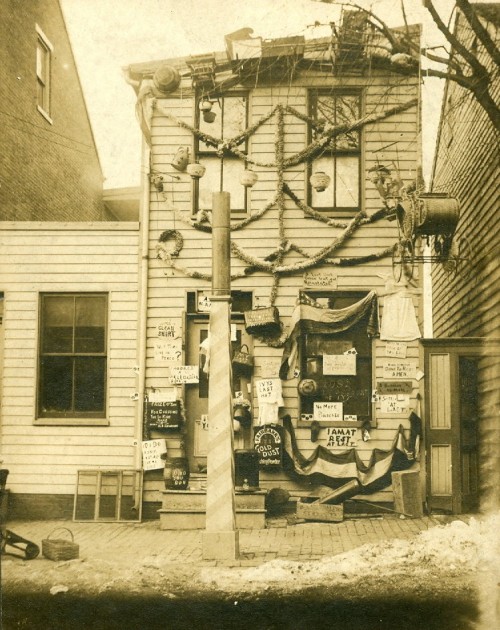
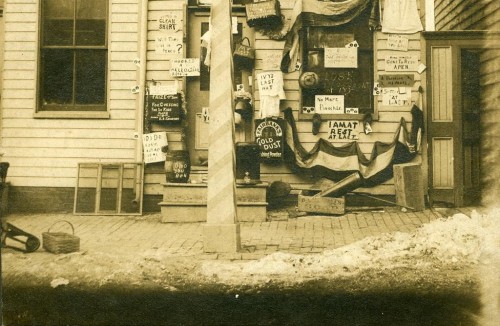
Additional seller notes:
Cabinet Card photograph circa 1890s-1900, measures 6″ x 7″, marked “This was taken when Ben Shriner was Married-Mrs. Joyce Roth, RD 6, York, Pa.”
This old glass movie slide was probably used in an old movie theatre at intermission or before the show started — when people would sing along with songs together rather than just collectively ignore the ads.
This antique glass slide by Maurice Workstel of New York is from a series called Song-Hit Slides and the lyrics shown are, “There are two sides to every story, But Nobody Listens to mine.”
Fabulous vintage fashions and transportation images; but I want to read more of the song! Anyone know more about the song itself?
Since I love old beauty tips and their cultural context, I was intrigued by A Slip of a Girl’s posts sharing clippings from the March 1831 issue of Atkinson’s Casket (aka The Casket). In that same issue, found via Google Books, I found this great article on painting on glass — but I wanted more.
In another issue, from 1832, this incredible review of Frances Trollope‘s Domestic Manners of the Americans (1832):
Mrs. Trollope has treated America with the same liberality, and her success in depicting the character of our people, has been nearly as great as captain Hall’s. An unsuccessful speculation in Cincinnati, awakened, it appears, the indignation of Madame T. and she forthwith—with the assistance of the notorious Fanny Wright, with whom she travelled, and whose abominable doctrines she appears to have imbibed—resolved to glut her revenge by writing a book. No doubt she is now satisfied, for she has the pleasure of seeing it stated in print, sanctioned by her name, that the Americana are the most illnatured, ungenerous, wicked, illiterate and vulgar people on the face of the earth ; that their moral sentiment is less elevated than that of the savages, and that the half-horse and half-alligator population of the Mississippi Valley, are as uncouth and as barbarous as a nation of Ourangutangs.
Mrs. Trollope, however, certainly unwittingly, pays American ladies, a very high compliment. Having fixed upon the society of Almacks as the criterion by which to examine the character of our ladies, she finds that they are all utterly destitute of polish; of that easy, lady like deportment, by which English ladies are distinguished throughput the world, and entirely ignorant of those amiable accomplishments in maneuvering, &c. which give her own countrywomen so strong an influence over their husbands. Our ladies are too modest in their behaviour and dress, to meet the views of Mrs. T. ; in company they want loquacity ; they seldom visit theatres; they arc respectful to their husbands, and indefatigable in instructing their children ; they are but indifferent dancers, and speak Italian shockingly incorrect ; and finally they are not carried away with foolish and ridiculous fashions. All these are serious faults in the opinion of the immaculate Trollope, and she vents her spleen at them in no measured terms.
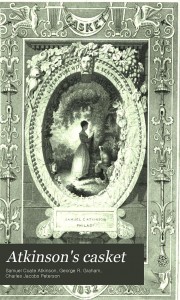 Trollope’s sentiments seem very much to echo those of this article from 1907 — so much so, that I double-checked that Trollope was indeed deceased in 1863. However, as this article, titled British Cockney Writers, shows, this apparently was quite the trend during this period.
Trollope’s sentiments seem very much to echo those of this article from 1907 — so much so, that I double-checked that Trollope was indeed deceased in 1863. However, as this article, titled British Cockney Writers, shows, this apparently was quite the trend during this period.
Included in this issue of Atkinson’s Casket are some excerpts or “extracts” — of which I found the following quite amusing:
The ladies have strange ways of adding to their charms. They powder themselves immoderately, face, neck, and arms, with pulverised starch; the effect is indescribably disagreeable by daylight, and not very favorable at any time. They are also most unhappily partial to false hair,which they wear in surprising quantities; this is the more to be lamented, as they generally have very fine hair of their own. I suspect this fashion to arise from an indolent mode of making their toilette, and from accomplished ladies’ maids not being very abundant; it is less trouble to append a bunch of waving curls here, there and every where, than to keep their native tresses in perfect order.
Though the expense of the ladies’ dress greatly exceeds, in proportion to their generalstyle of living, that of the ladies of Europe, it is very far (excepting in Philadelphia) from being |n good taste. They do not consult the seasons in tne colors, or in the style of their costume; 1 have often shivered at seeing a young beauty picking her way through the snow with a pale rose-colored bonnet, set on the very top of her head: I knew one young lady whose pretty little ear was actually frost-bitten from being thus exposed.— They never wear muffs or boots, and appear extremely shocked at the sight of comfortaole walking shoes, and cotton stockings, even when they have to step to their sleighs over ice and snow.
They walk in the middle of winter with their poor little toes pinched into a miniature slipper, incapable of excluding as much moisture as might bedew a primrose. I must say in their excuse, however, that they have, almost universally, extremely pretty feet. They do not walk well, nor, in fact, do they ever appear to advantage when in movement. I know not why this should be, for they have abundance of French dancing masters among them, but somehow or other it is the fact. I fancied I could often trace a mixture of affectation and of shyness in their little mincing unsteady step, and the ever changing position of the hands. They do not dance well; perhaps 1 should rather say, they do not look well when dancing; lovely as their faces arc, they cannot, in a position that exhibits the whole person, atone for the want of tournun-. and for the universal defect in the formation of the bust, which is rarely full, or gracefully formed.
PS Apparently this had all been previously published in The Saturday Evening Post; the connections between and history of The Casket and The Saturday Evening Post are well documented here.
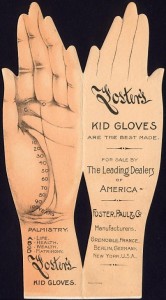 Hey, that conference I’m presenting at, the first annual Bookmark Collectors Virtual Convention, has been written up in the Seattle Post-Intelligencer. Which reminded me that I had not mentioned the event here, pestering you to attend. So, here it is, “Will you please attend the convention?”
Hey, that conference I’m presenting at, the first annual Bookmark Collectors Virtual Convention, has been written up in the Seattle Post-Intelligencer. Which reminded me that I had not mentioned the event here, pestering you to attend. So, here it is, “Will you please attend the convention?”
I think there’s still some free commemorative bookmarks available, so check that out before you register.
And, in case you missed it, here’s my story about incidentally collecting bookmarks: When I Was A Child, I Bookmarked As A Child (Or, Seeking The Perfect Bookmark).
Image Credits: This bookmark advertising Paul Foster & Co. kid gloves also features palmistry; it was submitted to the convention’s gallery by Laine Farley.
I’m completely smitten with these 1916 M.J. Moriarty Playing Cards featuring the leading ladies and gents of the silent silver screen.
I found them when I found my buddy Cliff Aliperti (who deals in vintage movie collectibles, especially movie cards and other ephemera) in chat and asked him if he had a photo or scan of something featuring Florence LaBadie for a silent film article I was writing. When he sent me two options, I, the too easily smitten, replied, “Damn you, those cards are cool!”
“Which ones? The playing cards or the pink borders?” Cliff types back.
“Both, actually,” I reply. “I like the playing cards a lot — but I’m a girl and pink scrolls are sexy too.”
He sends me links to more — purely to torture me, I am sure.
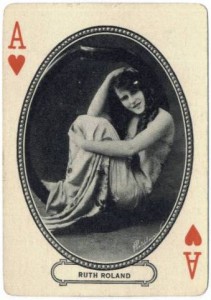 And while I’m looking them over, he tells me more about these old playing cards. “But the fun is there’s different cards in some decks … I’ve seen over 100 different cards. Ruth Roland, on one of the Aces, there are actually 4 different poses for the single card. But some of the variations are totally different stars — like one deck shows Norma and Constance Talmadge together, another has them on 2 separate cards.”
And while I’m looking them over, he tells me more about these old playing cards. “But the fun is there’s different cards in some decks … I’ve seen over 100 different cards. Ruth Roland, on one of the Aces, there are actually 4 different poses for the single card. But some of the variations are totally different stars — like one deck shows Norma and Constance Talmadge together, another has them on 2 separate cards.”
At this point, all I could say was, “Dude, stop messing with my head! It’s not nice to do that to obsessives.”
Like Cliff, you know I am obsessive with stuff; so y’all know I was half begging him to stop, half in love with the idea of hunting down all the variations.
I mean Charlie Chaplin as the Joker? Awesome!
Plus these cards feature silent film stars I’ve never even heard of — oh, the glory of the hours of research!
You can get more details and see all the cards in the gallery at Cliff’s site; and you can buy cards from him in his store, Move Cards For Sale, and in his eBay listings.
I love these vintage cast iron cat bookends — their snarling faces and their wide-to-the-side ears are a warning to those who would handle my books without purr-mission or without great care.
The seller, wheelboy antiques, says these bookends are by Snead Co., and are marked with the date of 1925 — and apparently, some people think these cats are bats?!
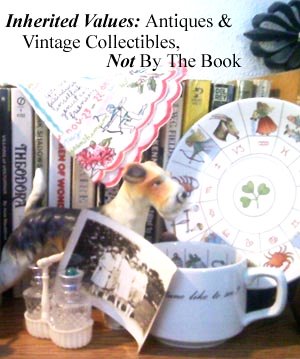 ‘Cuz you know I just don’t have enough to do what with moving the sites and all…
‘Cuz you know I just don’t have enough to do what with moving the sites and all…
I’ve started Inherited Values, a new network for lovers of antiques and vintage collectibles. It’s not a site about “how much something is worth” in the monetary sense; it’s about the values in the objects themselves — and it’s far more nostalgic and sentimental then I here, where I’m passing out the kitsch slaps *wink*
I started Inherited Values because I wanted a place where I could, with other moms and pops in the biz, focus on and share the joys of collecting old things, specifically. And do it in a more nostalgic, personal, and (I hope) beguiling way.
As the site tagline says, we don’t do antiques and vintage collectibles by the book!
We do, however, aim to assist antiques and vintage collectibles, be they handed down to you or the heirlooms you’ll one day leave behind, in charming the proverbial pants off you.
The site is live now (so if you’re a collector I do invite you to come on over!), but we’re still looking for a few dealers of antiques and sellers of vintage collectibles to join us. Email me at Deanna.Pop.Tart@gmail.com if you’re interested in joining the ne
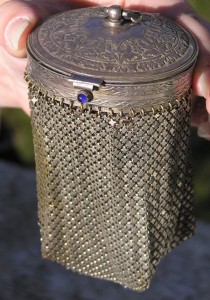 On Saturday I got my first real antique purses — and, as usual, I’m obsessing over researching what I can about them. Today I’m going to inform you about the fascinating things I learned about antique metal mesh bags by Mandalian Manufacturing Company.
On Saturday I got my first real antique purses — and, as usual, I’m obsessing over researching what I can about them. Today I’m going to inform you about the fascinating things I learned about antique metal mesh bags by Mandalian Manufacturing Company.
First a bit of history.
Armor mesh bags by Mandalian are as sought after as those by Whiting & Davis. Though, admittedly, metal mesh and chain had been used for quite some time, Whiting is often credited for having developed the technique for the first mesh bags in 1892. He then partnered with Davis in 1896 and when the mesh machine was invented in 1909, Whiting & Davis acquired the patent. This not only affected the cottage industry of women who hand soldered the up to 100,000 links per bag, but limited big business. However, companies keep trying because the metal mesh bags were only becoming more popular.
One of these was Sahatiel Gabrabed Mandalian, an Indian immigrant * who was focused on quality more than quantity. This is noted in A) the remaining purses themselves; B) the quantity of advertising (Whiting & Davis papered the world promoting their larger production runs, while Mandalians’ ads and inventory were much fewer in number)’ and C) the number of patents Mandalian held — with quite a few in metal mesh and enamel application, as well as jewelry and other accessories.
One of the ways Mandalian separated his mesh bags was with the invention of applying crushed fish scale to the mesh, creating a ‘pearlized mesh’ the company promoted early on, as this vintage tag shows, Color-Vision-Bag, Trade Mark, Process patent Pending
However, the name most of these vintage bags sold under was Lustro-Pearl, exhibited here by this Mandalian mesh purse with original box and tag.
But fashion accessories weren’t the only things Mandalian envisioned — for his Lustro-Pearl, or his mesh metal. In the May 19, 1931, issue of Exhibitors Forum (page 6), this news:
“Lustro-Pearl” New Metal Type Screen
A new type metal mesh projection screen, known as “Lustro-Pearl,” has been placed on the market by Mandalian Manufacturing Co., of North Attleboro, Mass.
The advanced features claimed for this new screen includes: A surface treated with the purest of known chemicals, entirely free from gloss, eliminating all distortion to ordinary types.
Highest reflection factor known to reputable light testing laboratories, effecting a considerable saving of electric current.
Constructed so as to distribute sound very clearly and uniformly throughout the entire theatre.
Can be washed with hot water and soft brush without injury to its surface.
Affords clear view of any picture from any angle of observation, eliminating eye strain or discomfort to patrons.
Surface may be sprayed periodically for many years, and for this purpose, the company plans to loan for a period of ten years a complete up-to-date spraying outfit with each screen purchased, and furnish chemical solutions from time to time for resurfacing this type of screen.
Its high reflective qualities bring out objects in a manner which might be termed the nearest approach to three dimensional pictures, the company claims.
RKO Proctor’s 58th Street, New York, is among the first houses to install this new type of screen.
(This patent, #1,890,819, was issued December 13, 1932.)
But eventually even the better made and more stylized mesh bags by Mandalian couldn’t compete with Whiting & Davis who, by 1944, added Mandalian Mfg. Co. to their list of competitors they’d bought out. Sahatiel G. Mandalian would pass away just five years later.
I could find no record of whether or not that included the film projection screens — or if that business had folded long before 1944. Any info is appreciated!
*
UPDTATE: Per comments, Sahatiel was not Indian but an Armenian immigrant born in Constantinople, Turkey.
I have a modest collection of vintage vanity items. (My collection and I have even been featured in Collectors News magazine.) And indeed, I’ve often wondered about the vast popularity of Rachel as a powder shade. I’d rather believed the hype that this particular shade was named after a popular actress at the time — but in Antique Personal Possessions, Silvia Druitt gives another possible reason:
In the very limited colour ranges obtainable then and up to the 1930’s, one frequently finds the colour Rachel. This takes its name either from the actress of that name, or, more probably, from a certain Madame Rachel who set up a Salon in New Bond Street, London, in 1863, and had a great success. Alas for her many clients, most of whom wished to keep their visits dark, her most lucrative profession turned out to be a sideline in blackmail. After mulcting many, she ended her career as a beauty specialist in prison.
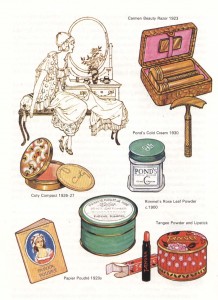 The blackmail was possible because at that time, colored cosmetics were not for ladies, only for prostitutes and/or actresses — the latter of which was equally reviled and in fact, the words ‘actress’ and ‘whore’ were synonymous to many. This whore/Madonna beauty thing is partly why I began collecting/studying such things, so how intriguing to discover Madam Rachel!
The blackmail was possible because at that time, colored cosmetics were not for ladies, only for prostitutes and/or actresses — the latter of which was equally reviled and in fact, the words ‘actress’ and ‘whore’ were synonymous to many. This whore/Madonna beauty thing is partly why I began collecting/studying such things, so how intriguing to discover Madam Rachel!
For more on Madam Rachel, I send you to Madame Rachel: Beautiful for Ever at Victorian History, and to Internet Archive for The extraordinary life & trial of Madame Rachel at the Central Criminal Court, Old Bailey, London : on the 22 23, 24 & 25, September, 1868. (If the link doesn’t work; search Archive.org for “Madame Rachel at the Central Criminal Court” and you’ll find it.)
I now eagerly await the publication of Helen Rappaport’s Beautiful for Ever: Madame Rachel of Bond Street -Cosmetician, Con-artist and Blackmailer for more information on this woman who spurned society and spawned so many powdered faces.
 Welcome to edition number seven of the History Is Ephemeral Carnival, where ephemera lovers share the history behind their obsessions.
Welcome to edition number seven of the History Is Ephemeral Carnival, where ephemera lovers share the history behind their obsessions.
If you’ve got posts about old paper and other ephemera, please submit them for next month’s carnival via the carnival’s submission form!
As Pop Tart I present “the meek do not inherit the earth — or at least that part of it presided over by the American political system” posted at Purple Pud Muddle. (Some scary facts about activism!)
Derek talks about his collection of Folk Art Postage Stamps (1977-1980) and WWII stamps at Collectors’ Quest. (You don’t have to beat ’em to lick ’em!)
At Here’s Looking Like You, Kid, Jaynie goes in search of Dorothy Gray’s Cherry Bounce. (She’s still looking for some help!)
Shawnee presents Living With Extended Family: The Ultimate Mother-In-Law Nightmare, Or A Gift? posted at Purple Pud Muddle. (Can we learn from the past — in this economy?)
At Collectors’ Quest, both and Collin and Derek dish about exonumia, with My Summer In Exonumia and Adventures In Exonumia, respectively. (First I didn’t know what exonumia was, then there’s multiple posts about it!)
Cliff shows us 1939 Rothmans Beauties of Cinema Tobacco Cards over at his movie collectibles blog at Things-And-Other-Stuff. (Pretty, pretty!)
Also at Here’s Looking Like You, Kid, Jaynie looks at a few past predictions: The Death of “New Look” Fashions & Other Fashion Predictions from 1950 and Film Options Are Like Predictions: Made, But Not Always Fruitful. (Hindsight sure helps with predictions!)
Here at Kitsch Slapped, I work hard to find out what this 1970 photo is about. (I could use some additional info, if you’ve got it.)
Honorable Mention:
My Collectors Quest post about managing a collection.
That’s the end of this month’s edition of the History Is Ephemeral blog carnival; please submit your posts for next month’s carnival via the carnival’s submission form!
 Welcome to the seventh edition of the New Vintage Reviews Carnival, where we review “old stuff” — from the classics to the forgotten — that is likely new to someone…
Welcome to the seventh edition of the New Vintage Reviews Carnival, where we review “old stuff” — from the classics to the forgotten — that is likely new to someone…
Films:
Jaynie discusses Spencer Tracy as a father on film in Father’s Little Dividend over at Here’s Looking Like You, Kid.
Yours Truly reviews The Adventures of Ford Fairlane over at Kitschy Kitschy Coo.
Cliff Aliperti posted Peter Lorre stars in MGM’s Mad Love (1935) over at The Examiner.
Jaynie of Here’s Looking Like You, Kid has a review of The Goddess. (I love this film!)
Cliff Aliperti on Warren William in Arsene Lupin Returns over at Warren-William.com. (Can you tell he’s a Warren William fan?)
Books:
Kerrie reviews Why Didn’t They Ask Evans? by the Queen of the Golden Age of Mysteries, Agatha Christie, at Mysteries in Paradise.
Yours Truly reviews Mary Stewart’s Airs Above The Ground here at Kitsch Slapped.
At The Viewspaper, Surbhi Bhatia reviews the classic Rebecca, by Daphne du Maurier.
Alessia (of Relationship Underarm Stick) takes a quick look at the vintage fortune-telling book, Fortune-Telling by Cards — and you can find excerpts here.
Mee reviews Breakfast at Tiffany’s: A Short Novel and Three Stories, by Truman Capote, at Books of Mee.
At Collectors’ Quest, I review Magnificent Obsessions.
Surbhi Bhatia, of The Viewspaper, reviews Carl Sagan’s Cosmos.
Monte Cook reviews the three original Dungeons & Dragons books at The Escapist.
Games:
In A Board Game Fit For a Suffragette, Thursday Bram reviews Pank-A-Squith, a suffrage-themed board game posted at Science of Board Games.
Yours Truly reviews the Dark Shadows‘ game, Barnabas Collins, here at Kitsch Slapped.
Etc.
Cindi Albright‘s What’s in your Vintage Cookie Jars? (at Muggsey & Mae Vintage Collectibles) is an unusual review of cookie jars.
At VintageMeld.com, Cliff Aliperti reviews the 300 Piece Uruguayan Movie Card Set.
Honorable Mentions:
My old live-Twitter account of Night of the Lepus at Kitschy Kitschy Coo might fit your Halloween mood…
Hyde and Seek doesn’t review games so much as present a visual museum of vintage Australian games, but it’s cool to see!
There’s also some “old books” in the 29th edition of the Book Review Blog Carnival I hosted — so check ’em out!
If you’d like your review to be in the next edition, please submit it (or one you’ve read) to the next edition of the blog carnival using the carnival submission form. (If you’d like to host the carnival at you blog, just let me know!)
 Welcome to edition number six of the History Is Ephemeral Carnival, where ephemera lovers share the history behind their obsessions.
Welcome to edition number six of the History Is Ephemeral Carnival, where ephemera lovers share the history behind their obsessions.
(If you’ve got posts about old paper and other ephemera, please submit them for next month’s carnival via the carnival’s submission form!)
Because there are 13 links in this edition, this post is also a Thursday Thirteen!
#1 History Cellar shares a Boston Restaurant Dinner Menu from the 1860’s over at The History Cellar. Can you afford the Potted Pigeon?
#2 Derek talks Irish Republic Bonds (from the 1860s – 1880s) at Collectors’ Quest. Do you know what they have to do with one of the earliest attempts to build combat submarines and plans to take over Canada and hold it for ransom?
#3 Yours truly has one of her antique postcards displayed in a museum; the story is posted here at Kitsch Slapped. (It’s so thrilling!)
#4 Jianfeng presents images which remind him of his grandfather in China’s Civil War in The Big Retreat in 1949 and My Grandfather posted at Jianfeng’s Blog. I think it shows how the details of individual stories somehow make things universal.
#5 Collin talks about The Brush Project at Collectors’ Quest. I never thought about it before, but artist brushes certainly are ephemeral.
#6 Yours truly interviews Troy Pedersen, owner of a real world vintage magazine store — in my neighborhood! Aren’t you jealous!
#7 Cliff, with the help of John Gingles of JG Collectibles, gives us A Peek at a Rare Harry Houdini Signed Photograph at Vintage Meld. Included is a tip on how to preserve and display such unique items.
#8 Frank reflects on This is Ephemera: Collecting Printed Throwaways, by Maurice Rickard at his blog, Antiquarian Holographica. Find out why Frank recommends the book and appreciates it for what others might call its short-comings.
#9 Val Ubell dishes about Silent Star Lucille Ricksen from an article in a 1925 issue of Jim Jam Jems over at Collectors’ Quest. I collect Jim Jam Jems myself, but don’t yet have that issue — so now I’m even more hot on the issue’s trail.
#10 Yours truly will be a presenter at the first Bookmark Collectors Virtual Convention. More details to follow at the official convention’s website; subscribe for updates!
#11 History Cellar shows us the Record of football deaths and injuries in 1900 at The History Cellar. Are things better or worse in the sport now?
#12 Yours truly finds out that her laminated in-flight instruction card for TWA’s Convair 880 jet holds a place in aviation disaster history, at Collectors’ Quest. Maybe you have items to help with the memorial?
#13 And if you’re not too sick of me &/or ephemera already, I’ve been interviewed on The Ephemera Show! Check out the podcast here.
While you’re here, let me also remind you that today’s the final day to submit for this month’s New Vintage Reviews Carnival — and, I’m hosting the next Book Review Blog Carnival. Please submit your posts!
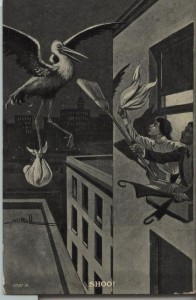 A few months ago, a gentleman contacted me about one of the items in my “vintage stork” collection. The antique postcard, postmarked 1908, depicts a couple shoo-ing away a baby-delivering stork; the gentleman was James M. Edmonson, Ph.D., Chief Curator of the Dittrick Medical History Center and Museum at the Case Western Reserve University; and he was asking if I could get him a larger high resolution scan of the postcard for inclusion in a new gallery the museum was working on.
A few months ago, a gentleman contacted me about one of the items in my “vintage stork” collection. The antique postcard, postmarked 1908, depicts a couple shoo-ing away a baby-delivering stork; the gentleman was James M. Edmonson, Ph.D., Chief Curator of the Dittrick Medical History Center and Museum at the Case Western Reserve University; and he was asking if I could get him a larger high resolution scan of the postcard for inclusion in a new gallery the museum was working on.
Could I? Would I? Um, this is exactly the sort of stuff that floats my boat! Not only is my object connecting me with others, with history, but the gallery is for Virtue, Vice, and Contraband: A History of Contraception in America — a new exhibit at the Dittrick Medical History Center and Museum that examines 200 years of the history of contraception in the United States.
So, naturally I did whatever I could to get the chief curator the graphic. And here it is, on the left-hand side of the display designed by guest curator Jimmy Wilkinson Meyer from The College of Wooster:
The exhibit (launched September 17, with Helen Lefkowitz Horowitz, author of Rereading Sex: Battles over Sexual Knowledge and Suppression in the 19th Century America, at the Zverina Lecture), depicts the social and cultural climate that influenced birth control decisions in this country, says James Edmonson, chief curator at the Dittrick:
The exhibit reveals a longstanding ignorance of essential facts of human conception. For example, that a woman’s ovulation time was not discovered until the 1930s by two doctors, Kyusaku Ogino in Japan and Hermann Knaus in Austria. Before and after this finding, desperate women went to great length to prevent pregnancies. The exhibit explores less well known (and dangerous) methods such as douching with Lysol or eating poisonous herbs like pennyroyal, as well as conventional means such as the IUD or the Pill.
“A remarkable body of literature was available to assist newly married couples and others,” says Edmonson. “These books were not displayed publicly, on the coffee table, but hidden in a private place.”
He cites examples such as Charles Knowlton’s Fruits of Philosophy, or the Private Companion of Young Married People (1832) and the popular 18th century book on anatomy, reproduction, and childbirth, Aristotle’s Masterpiece.
In addition to literature, the exhibit draws upon and incorporates the vast collection of contraception devices donated to the university in 2005 by Percy Skuy. The Canadian collector had amassed the world’s largest collections of such devices over the course of four decades.
The exhibit starts in the early 1800s, before Anthony Comstock, lobbied Congress to pass the Comstock Act of 1873, responding to what he viewed as a moral decline after the Civil War.
“It was a watershed year. The Comstock Act made it illegal to sell contraceptives or literature about contraception through the mail,” says Edmonson.
While Congress legally barred contraception, a black market for such products and literature flourished. Comstock went undercover to search out and turn in violators of his law in his crusade to stamp out what he defined as smut and obscenity.
In the early 20th century, women’s advocate Margaret Sanger opened a birth control clinic and research institute, flaunting the Comstock Law. Eventually her efforts evolved into the Planned Parenthood Federation of America.
The exhibition highlights some ancient methods of birth control and presents information about the influence of religion on contraception.
“We wanted to have a multi-faceted look at the topic of contraception,” Edmonson says.
Future plans are to expand this exhibit with a companion book, a kiosk where additional information can be accessed on the birth control collection, and an extensive online site available worldwide.
I love that my old postcard is hanging out with Margaret Sanger — well, it does that here at home, but now it’s part of the larger public story. And that’s cool.
Now I must get myself to Cleveland, Ohio to see it!
An amazing entry I found in The Journal of American History, Volume XI, January-February-March, No. 1, (copyright, 1917, The National Historical Society) which speaks as much to direct marketing responses as it does to attitudes about media. The National Historical Society, seeking to increase membership and circulation of the journal, had been “prosecuting a very extensive postal card campaign.” One of the recipients of the direct marketing response cards sent in a reply:
Dear Sirs:
I respectfully decline to become a member of your society. I have absolutely no faith in American History. When the history of this great war will be written then you will have to take your information from the American newspapers, which have published more lies during the last 2 years than have been published since the beginning of the world. Yours truly,
C. SEITZ.
The journal also notes that the correspondence was sent to the New York Tribune, where a representative of the newspaper tried interview Mr. Seitz by telephone. All Mr. Seitz would say in reply was, “You are all liars. I would not speak to you.”
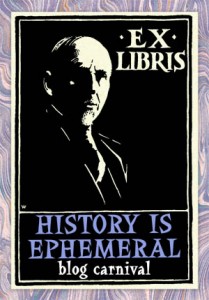 Welcome to edition number five of the History Is Ephemeral Carnival, where ephemera & history lovers share & obsess. (If you’ve got posts about old paper, please submit them to this monthly carnival via the carnival’s submission form.)
Welcome to edition number five of the History Is Ephemeral Carnival, where ephemera & history lovers share & obsess. (If you’ve got posts about old paper, please submit them to this monthly carnival via the carnival’s submission form.)
Derek (my hubby) dishes on Hell Bank Notes at Collectors’ Quest.
Monda gives us a little accidental Southern history in Reading the Minutes posted at Fresh Ribbon.
I predict that the next hot ephemera trend will be in ERA collectibles posted at Collectors’ Quest.
The Dean talks about ephemera as local history at Collectors’ Quest.
Frank shows us groovy Grateful Dead holography over at Antiquarian Holographica.
Val Ubell shows us adorable cabinet photos featuring children and vintage photographs featuring ladies’ hats at Collectors’ Quest.
At Things and Other Stuff, Cliff shows off 1936 Godfrey Phillips Stars of the Screen Tobacco Cards — don’t miss the gallery!
At Ephemera, Marty shows us golden age of Hollywood autographs as well as a letter sent to Marilyn Monroe.
My husband also gets an Honorable Mention for his review of David Downie’s new novel Paris City of Night, a story that combines terrorism, auction house fraud, murder, photography (daguerreotypes), and Nazis into a mystery.
And I remind all you collectors and history fans to help museums! Puh-leeeze.
First my disclaimer: I sadly do not own this old advertisement & instructions for the “Dainty Maid Outfit” (douche bag, antiseptic powder, and syringe); I found it while searching at the Library of Congress for photos of Margaret Sanger for the eugenics post.
The reason I didn’t include it then & want to discuss it now is two-fold.
One, there’s some confusion over Sanger’s connection to the item.
While the LoC notes that this paper, published between 1900 and 1930, was part of Sanger’s collection, saying, “Like many of her contemporaries, she retained all kinds of printed matter accumulated during her career, including pamphlets like this one relating to women’s gynecological health and hygiene,” it’s not entirely clear that this is the end of the antique ephemera’s story.
In 2006, the Margaret Sanger Papers Project (MSPP) reported this (links added by moi):
In his recent book, Men of Tomorrow: Geeks, Gangsters, and the Birth of the Comic Book (New York, 2004), author Gerard Jones highlights the role played by the poet and editor Harold Hersey in the pulp publishing industry. Hersey, one of Sanger’s lovers in the late 1910s, later wrote an unpublished biography of Sanger. He worked closely with Sanger in the early days of the Birth Control Review. “We didn’t only sell magazines,” Jones quotes Hersey as saying, “but also razor blades and other items.” “The ‘other items’,” Jones explains, “were contraceptives. Sanger was not only a proponent of birth control but a mail-order dealer, with her own line of condoms, diaphragms, and ‘Dainty Maid’ douche kits.” That is new information to us. Sanger was always extremely careful never to associate with the commercial trade of contraceptives. Her opponents often accused her of profiting from her cause, but there has never been a shred of evidence she received money for selling birth control or taking part in a mail order business – under or above ground. It is possible that one distributor of the Review, Eastern News, used its sales network to send illegal publications, condoms and liquor around the country, but most likely Sanger had no knowledge of it. For his sources, Jones cites Hersey’s autobiography, Pulpwood Editor, which does not mention the mail order venture, and unspecified collected material by Michael Feldman, a researcher on the comic book business. Thanks to Professor Ed Shannon for bringing this one to our attention.
However, there was a 2007 release The New Pulpwood Editor also. And, despite claims to Hersey’s “unpublished biography” of Sanger, others claim to have a copy. All of which not only further confuses things in terms of what source was used, but leaves the accuracy of Hersey too far down the pecking list at this point to even verify it.
But regardless of the characters involved & their individual characters regarding telling tales (& proper documentation of sources), how can the MSPP claim Sanger’s ignorance to The Dainty Maid Outfit when the LoC has it — and in their Margaret Sanger collection (Papers of Margaret Sanger, container 252) yet?
The second reason I brought this vintage female hygiene ad up separately should be apparent: researching is not for the timid, not the easily exhausted.
If this was a product Sanger offered via mail order, then perhaps The Dainty Maid was more than a cleansing douche… Contraceptive products, illegal at the time, were sometimes sold with the word “French” used as a secret code to communicate the “illicit” purposes of the product; either to wash away sperm post-coitus or perhaps even the “antiseptic powder” was even a spermicide.
When I snatched-up this antique postcard, I was so seduced by its charms that I thought I had something few had ever seen since the 1900’s; but, as it turns out, you can find scans & images of this old postcard a few places online.
But what makes my posting of it unique and interesting is that, unlike my compatriots who’ve shared the image, I am so smitten with ephemera that I must unlock its secrets & share those too…
The text reads:
When you’ve hosiery that’s pretty
And lingerie that’s swell
Come on to New York City Christine
And be a Flat Iron Belle
Now the crossing-out of New York City & replacing it with Christine (a small city in North Dakota) has been done by hand — but it is not inviting someone to a woman named Christine. *wink* It was done by the hand of what looks like an A.N. Gunderson who was cheeky enough to tailor the postcard into an August 22, 1909, invitation for (presumably) his friend, Alfrid Olson, to come visit him in Christine.
That historical personalization is cute; but I just kept wondering what the heck a “Flat Iron Belle” was.
Based on the rhyming text description and the “semi-photo” visual of ladies’ underthings, I just knew this card was special… But other than the afore mentioned images, searches for “Flat Iron Belle” didn’t turn anything up. So I turned to the real world and did some research.
I turned to my husband and asked, “Do you know what a ‘flat iron belle’ is or was?”
He, the all-knowing, all-seeing Wizard of Odd, informed me that there was a Flatiron building. (It is so useful, when stuck, to utter a question and have your intelligent walking encyclopedia of a mate tell you not just ‘stuff,’ but the right stuff so you can continue your obsessive researching.)
From there, a hop skip & jump (over Wikipedia, which I mistrust intensely) to Columbia University’s The Architecture and Development of New York City with Andrew S. Dolkart & his entry on The Flatiron Building, “The first building to become a romantic symbol of New York.” Dolkart says:
[I]t was a symbol because of its triangular shape. Thus the name Flatiron, because it looked like the old irons that people used to iron clothing. It was originally called the Fuller Building because it was built by the Fuller Construction Company for its headquarters, but people almost immediately called it the Flatiron Building. The Fuller company understood the value of this name and popularity of the building, so they began calling it the Flatiron Building as well, and that became the name by which everybody knew this building.
OK, so now you understand the name — even if on the postcard it says “Flat Iron” rather than “Flatiron.” But what of the windswept skirts?
It was not only a building that appealed to high-art interests, such as people who were interested in Steichen’s photography or Hassam’s paintings, but this building also entered popular culture. It is at a triangular site where Broadway and Fifth Avenue—the two most important streets of New York—meet at Madison Square, and because of the juxtaposition of the streets and the park across the street, there was a wind-tunnel effect here. In the early twentieth century, men would hang out on the corner here on Twenty-third Street and watch the wind blowing women’s dresses up so that they could catch a little bit of ankle. This entered into popular culture and there are hundreds of postcards and illustrations of women with their dresses blowing up in front of the Flatiron Building. And it supposedly is where the slang expression “23 skidoo” comes from because the police would come and give the voyeurs the 23 skidoo to tell them to get out of the area.
So there you have it; “Flat Iron Belles” were the beauties looked at (or those who became beautiful by virtue of winds making a disarray of their virtuous skirts). And there, supposedly, is the reason for the phrase “twenty-three skidoo” too.
The questionable innocence of peeping Toms aside, I am at least comforted by the fact that the sole male in the scene is not one of those (hopefully) assisting the fallen wind-swept women. Those hands look more like they are stroking the fine underthings than reaching to help the fallen; so even if the problem is an unrefined artistic skill, at least I don’t have the nightmare of male (physical) assault.
Collectors, the information you seek to find this coveted card & add it to your collection is scant; you’re best bet is to search online for the lingerie verse, because the card has no markings save for number 78 on the front lower left hand corner and [K] Semi-photo on the back (like this one).
In 1857 (a year before Darwin’s The Origin of Species), creationists Dr. Josiah C. Nott and George Gliddon published Indigenous Races of the Earth, which included illustrations comparing the skulls of “Greeks,” “Negroes,” and Chimpanzees to suggest black people ranked between white people and chimps. All copies of Indigenous Races of the Earth were pre-sold before they were even printed and the book then went on to become one of the best selling books of the time, including being published in many languages.
At Forgotten Bookmarks, a visit to This Old Paper prompts this post pondering old paper:
Looking though their site, I wonder what it is about these old things that fascinates us. Why are we drawn to a simple note, a single sentence, just because it was written 100 years ago? We come across words that old all the time, and choose to ignore them. Often, we ignore them because they are old words, tired words (I’m looking at you, Charles Dickens). No, it must be the intimacy of the words, the moment. I like to think we are part-time anthropologists, dreaming up the birth and death of of these old things, the wheres and the whys; imagining the postcard dropped in box in 1910, the candlelight flickering across the parchment as a tired father reaches across the miles with his words to his family back home, a bored student passing the time in his 1951 Latin class by doodling the teacher with a monkey’s butt…
I have conjured up all these things and more, and I am just starting to realize that I prefer my version of history to anything that might have really happened. I am sure their lives were nearly as droll as ours.
I think it’s this and more, such as the tactile lending transcendence (the power of the objects) and the fact that life — and its intimate moments are the real stuff of history (more than the dates & events memorized)… But the post is an eloquent & excellent start.
This also serves as a reminder to submit your articles, posts, ponderings (or those you’ve enjoyed) to the next — and forthcoming — editions of the History Is Ephemeral carnival.
 Welcome to the third edition of the History Is Ephemeral Carnival, where collectors of ephemera & history lovers share & obsess. (If you’ve got old paper & their stories to share, please submit your post to this monthly carnival via the carnival’s submission form.)
Welcome to the third edition of the History Is Ephemeral Carnival, where collectors of ephemera & history lovers share & obsess. (If you’ve got old paper & their stories to share, please submit your post to this monthly carnival via the carnival’s submission form.)
Old Clippings & Articles:
Hot On The Historical Ephemera Trail… In The National Enquirer?, written by me & published at Collectors’ Quest.
Andrew Amelinckx presents The Belgian paupers posted at Old Smoke Bio, saying, “While doing research for a book I’m writing, “Old Smoke,” I came across a small article on 12 Belgian immigrants who ended up in a NYC jail. Being of Belgian ancestry it peaked my interest and here is the result.”
Cliff Aliperti presents The Sporting News Coverage of Lou Gehrig Surpassing Everett Scott’s Record posted at VintageMeld.com.
I’ve also published Now It’s Really The Last Laugh & Twitter Of 1950 here at Kitsch Slapped.
Old Books, Pamphlets & Publications:
Jdou presents Late-breaking news on Regnault-Warin’s controversy posted at A Revolution in Fiction, saying, “Tantalizing hints unearthed about an unknown best-seller of 1800, the novel _Le Cimetiere de la Madeleine_, which was searched, seized, and destroyed by the French police for over 2 years!”
In Chapter 419 Useful References About Ephemera, Chris Lowenstein of Book Hunter’s Holiday show us antique women’s suffrage publications.
Also, Chris shares a neat old pamphlet at The Fine Book Blog.
Azrael Brown Acquisitions: Hansi’s New Life posted at Double-Breasted Dust-Jacket.
Stamps:
At Ephemera, Marty Weil presents Lincoln Ice House Cover Stamp.
Photos, Postcards, Etc.
At Stage Whispers, Carla Cushman has two excellent pieces: Drag Kings of Theater and Drag Queens of Theater.
Tattered & Lost presents Is She Or Isn’t She? posted at Tattered and Lost Photographs.
Honorable Mentions:
GrrlScientist‘s Unholy Business: A True Tale of Faith, Greed and Forgery in the Holy Land (posted at Living the Scientific Life) is a review of Nina Burleigh’s book on one of the greatest hoaxes of all time — which includes the forged Joash Tablet. Are stone tablets ephemeral? Maybe not; it depends on the purpose, I suppose… But I can’t resist a good case of historical fraud.
Also, don’t miss my review of The Soiling Of Old Glory, it’s a biography of one singular photograph. (And I sure learned a lot!)
That’s it for this edition! If you found some interesting ephemera, please, submit your blog post/article — or one you like — to the next edition of history is ephemeral using the carnival submission form. (Past posts and future hosts can be found on the blog carnival index page.)
Just a collection of what I’d call A-Nesting Fashion Hats — “bad bird hats,” if you prefer. Enjoy — and don’t have chicken for dinner. *wink*
And remember kids, a dead bird in the hand is worth two on your head!
Vintage hat photos via myvintagevogue, freeparking, solanah, and chiesavecchia collection’ at Flickr.
The Philistine: A Periodical of Protest was published by Elbert Hubbard, and so is yet another thing Roycrofter-tian. One of my husband’s obsessions, I am granted free access to and use of all of our duplicate copies, so you should expect to see them here from time to time.
Today I present advertisements for White Hyacinths and Woman’s Work — prominently featured in The Philistine because the books were written by none other than Elbert Hubbard & his wife, Alice Hubbard, respectively.
 (Ads, and “inspirational work advice,” from The Philistine, Vol. 26, March, No. 4, 1908)
(Ads, and “inspirational work advice,” from The Philistine, Vol. 26, March, No. 4, 1908)
The first book, as you can see by the old ads, is “a book for lovers — married or unmarried” — but don’t think it’s recommending scandalous romantic relationships prior to marriage; White Hyacinths is a book about one’s love affair with life & the earth, as seen in the book’s most complete title “So here cometh WHITE HYACINTHS Being a book of the heart by Elbert Hubbard wherein is an attempt to body forth ideas and ideals for the betterment of men, eke women, who are preparing for life by living.”
Intriguing, yes; but my personal vintage book lust is currently in hot pursuit of the second book, Alice’s Woman’s Work.
Tell me, ladies, that this ad copy doesn’t make you clap your hands with joy:
Woman has always been demoneized by male men. Mrs. Hubbard thinks this is an error for both parties and gurgles her disapprobation in Caslon. Woman’s services have been paid for in clearing house promises payable in Heaven.
…Scripture charges her with disarranging the plans of Deity; the Puritans invented and operated the ducking stool for her benefit; all of the twenty witches hanged at Salem were women; she was voted out of the General Conference of Methodists — although the mother of John and Charles Wesley, and seventeen other Wesleys, was a woman, and a preacher; a woman was recently sentenced to prison in England because she insisted on having her political preferences recorded; Blackstone calls her an undeveloped man; women are not allowed to speak in Episcopal nor Catholic churches; good priests refrain from loving women as a matter of conscience, and spiritual expediency, so it seemed necessary for Mrs. Hubbard to write this book as an apology for being on earth and an explanation regarding the weaker sect, and also the unfair sex.
Or this, from the second ad for the same book:
Here is heresy, proud and patent, telling why woman is a plaything for men when she is pink and twenty, and a drudge and scullion when winter touches her hair with the frost of years — sometimes. The worst about the Marital Steam Roller is that the race suffers.
Let no presumptuous person arise and dispute this fact: women are the mothers of men. And in spite of all we can do, the qualities of the mother are the heritage of her sons. To have a truthful, direct and gentle race of men who are strong enough to look each day in the eye, who are afraid of no man, and of whom no man is afraid, we must evolve a race of mothers who are not burdened by idleness, overwork, skimped allowances or the masculine idea of Run-and-Fetch-my-Slippers.
Mrs. Hubbard is a working woman. She is Vice-President and General Manager of The Roycrofters, a corporation that employs five hundred people. She has thoughts and expresses them.
(See full scans of ads, above and below, by clicking on them.)
 (Antique book ads from The Philistine, Vol. 27 October No. 5, 1909)
(Antique book ads from The Philistine, Vol. 27 October No. 5, 1909)
What’s not to love?
Sadly, copies of Women’s Work are difficult to come by. Isn’t that usually my luck? Or is that simply human nature to desire the harder to find object?
I suspect that even among the Roycrofters and fans of Roycrofters, that White Hyacinths’ beauty was far more appealing than the self & societal work presented in Alice’s book. I’m only guessing; I haven’t gotten my hands on either yet. (My Hubbard Cupboard is bare.)
The opening line in the 1909 ad for Woman’s Work read, “Men afraid of an Idea, or women incapable of the same, will do well to eschew the book by Alice Hubbard entitled Woman’s Work.”
From the looks of what few copies remain, most people preferred to eschew.
Or, maybe, just maybe, those who have the book love it so that they keep it close to their bosom.
On Sunday, I posted a review of sorts about an article titled People turn to education when times are tough, by Eric C. Rodenberg, which was published in Antique Week (February 2, 2009 edition). But that’s not all I have to say on the subject.
Also featured in that article was an interview with Joe Cohen, director of antiques classes for Florida’s Broward County Public Schools Adult Education Program.
(Discovering that Broward County website was not easy; Rodenberg’s article credit’s Cohen’s own site, www.antiqueclasses.com — which is stupidly constructed in images & flash, so that while Cohen will likely not enjoy what I’m about to say, he should console himself that there’s some text pointing to his website which is in desperate need of being found due to it’s own lack of text.)
Anyway, Rodenberg believes that Cohen “may best be described as a ‘scholar’ of antiques.” Something which puzzles & frustrates me. As you’ll soon see.
You might want to get a beverage and settle in for this rant. Go ahead; I’ll be here when you get back.
 After the blah-blah-blah of Cohen’s background and current instruction in the field, we get to this part, which concludes the article:
After the blah-blah-blah of Cohen’s background and current instruction in the field, we get to this part, which concludes the article:
In large part, Cohen maintains he is responding to a very basic need — accurate information — which, he believes, is lacking withing the antique industry.
“Invariably, when anyone buys something from me they ask, ‘what is the story behind this,'” he says. “It’s just human nature — people want to know the story behind a relic they may buy. And, in the past, that’s just what the dealer and the auctioneer has given them, a story.”
Given the proper tools, Cohen believes the dealers and auctioneers can do better. And, sometimes he believes the “instant gratification” of receiving information from the Internet is detrimental to the trade.
“On my first class, I put a dot on the blackboard,” he says, “and I tell the class to consider that the three acres around them on the campus contain all the information in the world. Within that three acres is all that is known within the world. And the tiny dot represents all the information, in the world, that can be found on the Internet. From there, I put a pinpoint in the middle of the dot. That, I say, represents all the correct information that can be found on the Internet.”
Opening the mysteries of the antique world is not an event, he seems to say, but a process. It may be a process that repays those who are knowledgeable in many ways.
“I find the beauty of antiques in the art, history and the physical properties of any one piece,” he says. “And I believe you cannot make a good decision without that background … an educated consumer is the best consumer.”
And the most satisfied.
And here’s where I defend my beloved Internet.
Not just because I love & live on the Internet (if you cut me, do I not bleed in pixels?), but because there’s so much that’s just plain wrong in what Cohen believes.
So much wrong that I don’t know where to begin…
And let’s not ignore the irony of a man who believes in “accurate information” vs. “a story” yet offers no facts, data or information in support of his own theories — in fact, let’s begin there.
I can draw an over-simplified illustration as a visual framework for a hypothesis on a chalkboard. Really I can. But no matter how artistic &/or convincing the drawing is and no matter how much I fervently believe what I am describing, neither the chalk drawing nor my passion for my own point of view makes it true. I’d really like to see the statistical data or any information gleaned from actual research on the reliability of information on the Internet versus any other medium.
If Cohen — or anyone else — is going to say that the self-publishing aspects of information presented on the Internet equates somehow to a general inferiority when compared to other forms of media, I’m going to, again, ask for proof — and then point to errors made in print. (Anyone else thinking of the fiasco that was A Million Little Pieces?)
Human error (and manipulation of the facts) runs as far back in history as humans themselves do.
In fact, as a researcher, I’ve run into this problem so often than I am loath to trust just one source — even when it’s a publication both from the time period being researched and one you should trust, like the manufacturer’s own catalog. They had printing errors (wrong stock numbers, missing models, good old typos, etc.) back then too, you know. And then, as now, if I’m reading a magazine or newspaper from 1950, who knows if they printed a retraction or correction in the next issue? (If I have the next issue, or access to a copy of it, you’d better believe I scour it for corrections and retractions — buried as they may be.) When reading second (or third, etc.) hand accounts, who knows how trustworthy anything is? Too many people have trouble understanding satire now; that’s probably always been a big issue…
Anyway, good researchers & journalists (professional or hobbyists) present and report their findings to the best of their ability, siting sources where they can, regardless of where the information is to be shared. The bottom line here: No method &/or means of the message’s delivery is inherently more (or less) likely to be rife with misinformation than another.
I’d think any scholar would know such a thing; conversely, I’d expect a person labeling another a “scholar,” to consider just what incongruous & unfounded things the person was saying prior to giving him or her that label. Yes, I’m speaking to you, Mr. Rodenberg, self-described “old newspaper man.”
I’m starting to wonder if anyone in this piece is interested in providing accurate information.
If Cohen’s reference to vast amounts of inaccurate information on the Internet was in regards to antique & collectibles sellers on the Internet, I again, ask for any data to that claim. I haven’t even heard of any studies regarding fraud or inaccurate antique and collectible sales on the Internet vs. “brick ‘n’ mortar” shops. “Bricks” don’t imply a more educated dealer than one found by “clicks.” (And, should you be at all alarmed about “bad sellers” on the Internet, please note that in the US, you’ve got fraud protection from the FBI — please see my article here — which is likely more coverage than you have with your local antique shop.)
On to the next point.
When it comes to the amount of information on antiques and collectibles available worldwide (the quantities of which, neither “real world” nor Internet, have been established) I would be very surprised if, at least in some areas, there wasn’t more of it available on the Internet. I don’t have any statistical data to back up such beliefs — but I am at least willing to provide a reasoning for them.
When it comes to media, books have been considered the least expensive when compared to film & television. Certainly, one can argue that other print publications are comparatively inexpensive as well. But in the age of the Internet, the Information Age, clearly digital pixels are even cheaper.
So while a more traditional (i.e. print) publisher may balk at publishing a work with such a small audience as say “magazines from the 1920s” — insisting that the work focus on a broader subject, such as magazines across several centuries — the author (dedicated researcher/obsessive collector) is literally free to publish on the Internet, where she will reach her audience, no matter what its percentage of total Internet readers.
In other words, works that wouldn’t be printed (or perhaps, with self-publishing books as a greater possibility than ever before, it’s more accurate to say such books wouldn’t be printed, marketed, and distributed), may be published on the Internet. Blogs immediately leap to mind, naturally, but there are many options. And with scanning and image uploading, these digital resources have no limits (save for the dedication of the person doing the work) on the quantity and quality of the illustrations, photos and digital image displays; something many publishers curtail for various (monetary, copyright permissions, etc.) reasons.
As a result, you can find blogs, pages, websites and entire communities dedicated to topics so tiny & obscure that you can’t find the information, let alone the visual representation, anywhere else.
Additionally, there’s the issue of access. Not all of us can get our hands on fragile old tomes & publications — not even the more modern copies on microfilm &/or microfiche. But here on the Internet we can see, share and communicate directly with one another — even correcting one another, as needed.
It’s not always about cheap “instant gratification,” buddy; it’s about access and collaboration. At least for those of us dedicated to our antiques and collectibles.
If Rodenberg was accurate in summarizing Cohen as saying that “opening the mysteries of the antique world is not an event, but a process,” then it was silly for either gentleman to ignore or diminish the value of both the hobbyist & the Internet in that process. The hobbyist, the amateur historian, the blogger, the passionate collector (however you identify yourself) and the Internet propel this process of opening the mysteries of the antique world.
If nothing else, we’re the ones who buy (subscribe) & read the very paper this damn article was published in.
Want more irony points? All this Internet-bashing was said in the guise of education — “an educated consumer is the best consumer” — yet they themselves are providing those consumers they reach with misleading information, if not complete mythinformation.
Consumer, beware indeed.
And now for the ultimate irony.
Years from now, when surviving (digital or print) copies of this issue of Antique Week article are discovered by future collectors, they will suffer from the false illusion that way back when, in 2009, the Internet was loaded with inaccurate information — that only a “pinpoint of chalk” of it was true.
They won’t (unless this post survives — and isn’t discounted by the researcher of the future!) know that neither Cohen nor Rodenberg had any basis in fact for saying such things. They won’t know that they were just two men stuck in their old thinking, promoting what they thought saved their own livelihoods: Cohen his classes and Rodenberg his “better than the Internet” paper reporting gig. So the researcher of the future may just go ahead and publish inaccurate information — in the most reliable & legitimate of publications of his time, yet.
(Huge sigh.)
If anyone here is just “telling stories” about antiques & collectibles, it’s these too men, Cohen and Rodenberg.
I have two problems when I turn to Google or any internet search engine: one is what’s missing, and the other is that I don’t know about something in order to find it.
The first issue is a problem with my obsession with researching my collectibles. So many times I hold something in my hand, but according to Google (and all the search engines & online archives I try) it doesn’t exist. You’d think with the number of times it happens, I’d no longer be surprised; but I continually am. And I also get frustrated. But eventually my compulsive need to know makes me get off my butt and head to libraries and make calls to institutions with specific archives and collections — and then I write about it online.
Yeah, I’m doing my best to stuff the internet with knowledge I wish already existed on it.
I do hope the other obsessive compulsives appreciate that.
The second issue is that when I don’t know that things exist (and that happens — because no matter how much hubby and I cram into our house & heads, we neither have everything nor know everything), how can I search for them?
I’m always on the look out for out of print books and vintage magazines & other publications to read. I love watching old movies, playing old boardgames, taking road trips to kitschy roadside attractions, and the like. But if I don’t know these things exist, how can I find out about them? And with folksonomy being a combination of “the personal” and “randomness”, who knows what keywords, tags &/or labels others would use to classify them?
I try, don’t get me wrong; but I end up with more unwanted stuff than a litter box.
To help myself — and those nerds like me — I’ve started two blog carnivals: The History Is Ephemeral Carnival and The New Vintage Reviews Carnival.
Please support the carnivals by submitting your posts/articles &/or those posts/articles by others, by informing you favorite bloggers who are equally nerdy, and by coming back to see the carnival goodies!
More vintage sheet music owned by Sister Patricia; this time, Story Poems with Musical Settings by Phyllis Fergus.
The song, The Woodpecker (copyright 1925 by Clayton F. Summy Co.), takes its lyrics from an anonymous poem previously published in The Millgate Monthly, and is dedicated to Fergus’ niece, Elizabeth Clifford. Something which likely makes poor Elizabeth cringe — roll over in her grave? — why couldn’t her aunt just pat her on the head and exclaim, “My haven’t you grown!” and give her an ugly frock like the rest of the relatives? Because this is one racist little song:
The Woodpecker
A woodpecker picks out a great many specks
Of sawdust when building his house.
He works like a nigger
To make the hole bigger,
He cuts thru’ the wood like a mouse.
He doesn’t bother with plans of cheap artisans,
But there’s one thing can rightly be said;
The whole excavation has this explanation
He builds it
By working, Well! by using his head!
Can’t you just imagine a classroom full of students with bright shining faces who, at the urging of Sister M. Patricia, are happily singing the n-word as part of their religious dedication?
Singing their way into heaven? Hmmm, more like sinning their way to hell.
Ah, but it was the times… The roaring, racist 20’s.
But if the image of a nun leading a choir of earthly angels in singing the n-word doesn’t illustrate how entrenched and insidious racism is, then what will?
If the name Clayton F. Summy sounds vaguely familiar, it likely is due to the Happy Birthday hullabaloo. (See also: Google Answers.) Which means that the same folks who claim to own the rights to Happy Birthday likely also own this racist little ditty.
Normally the most interesting thing to me about vintage sheet music is the cover art; this is because I’m musically illiterate and can’t use it for anything but decoration and/or parts for altered arts (honestly, the only way I am able to carry a tune is to buy sheet music *ba dum dum* ). But this weekend I bought hundreds of sheets of vintage sheet music & some of the most fascinating ones were those that had little to no artwork at all.
All of the pieces I’m showing you today were owned by one Sister M. Patricia, O.S.B. (Order of Saint Benedict), from Sacred Heart Convent, East Grand Forks, Minnesota. (Puzzling then, that at least The Naughty Little Clock Song sheet music would come all the way from Boston! Surely there was a cheaper option in the Twin Cities?)
But anyway, Sister M. Patricia was a racist nun — and I can say that based on her musical habits.
First up, her copy of Japanese Love Song, copyright 1900, words by “Anon”, music by Clayton Thomas aka Salome Thomas Cade aka Nellie Salome Thomas, and dedicated to Madame Alberto Randegger. Only Sister has crossed-out “Japanese” and replaced it with “Chinese” —
Because apparently one Asian is as good, or as heathen, as another. Hey, I’m not calling anyone a heathen! The original lyrics read:
She was a maid of Japan
He was the son of Choo Lee
She had a comb and a fan,
And he had two chests of tea.She wore a gown picturesque,
While he had a wonderful queue,
Her features were not statuesque,
Which matter’d but little to Choo, to Choo,
Which matter’d but little to Choo.He smiled at her over the way,
She coquetted at him with her fan;
“I mally you,–see?” we would say
To this queer little maid of Japan.And day after day she would pose
To attract him, her little Choo Lee,
All daintily tipp’d on her toes,
This love of a heathen Chi-nee, Chi-nee
This love of a heathen Chi-nee.But Fate was unkind to them, quite,
For he never could reach her, you see,
Though she always was there in his sight,
And she look’d all the day on Choo Lee;For a man mayn’t do more than he can,
Tho’ a maiden may languishing be,
When she is a maid on a fan,
And he’s on a package of tea, of tea,
And he’s on a package of tea, ah!
Her revisions also include changing lyrics in the newly created Chinese Love Song:
For continuity purposes, of course, “Japan” was changed to “Chi-nee”. And Sister is nothing if not consistent in her racism, as we’ll see in part two. (Yup, that’s a tease to come back soon.)
PS This little song was performed at a The New York Times, August 31, 1902:
The amazingly cute and gay lyrics to The Naughty Little Clock:
There once was a frivolous and giddy little clock,
A little French clock very gay;
Very trim and very neat but a creature of deceit,
When you wished to know the time of day.
It’s goings on would shock
The old hall clock, Till it held up its hand aghast;
I’m sure to tell the truth, It went wrong in early youth,
Had a natural inclination to be fast.Chorus:
Tic-toc, tic-toc, said the silly little clock,
“Oh, life in the house is slow,
So cold and grim, very dull and prim,
I’m getting run-down I know”
So she sighed all day for a life more gay,
She longed for a shady past.
This naughty little, haughty little clock, tic-toc,
That had an inclination to be fast.“I’m quite wound up,” declared the giddy little clock,
“I’m weary of the mantel shelf;
For years I’ve had to chime to give other folks the time,
Now I’d like to have a time myself.
I’d even run away
With a gay roué,
If he’s show me the town’s great sights;
So she took up with a lamp,
And incorrigible scamp,
Who smoked and always went out nights.Tic-toc, tic-toc, said the foolish little clock,
“Oh, won’t you elope with me?
I’m yours from today if you’ll take me away
Where something of life I’ll see.
Well, they ne’er came back and the bric-a-brac
Had scandal enough to last
In gossiping about the little clock, tic-toc,
That had an inclination to be fast.
Copyright 1899; music by Reginald De Koven, lyrics by Harry B. Smith. (My copy of the sheet music states that the copyright was assigned 1930 to Theodore Presser Co.)